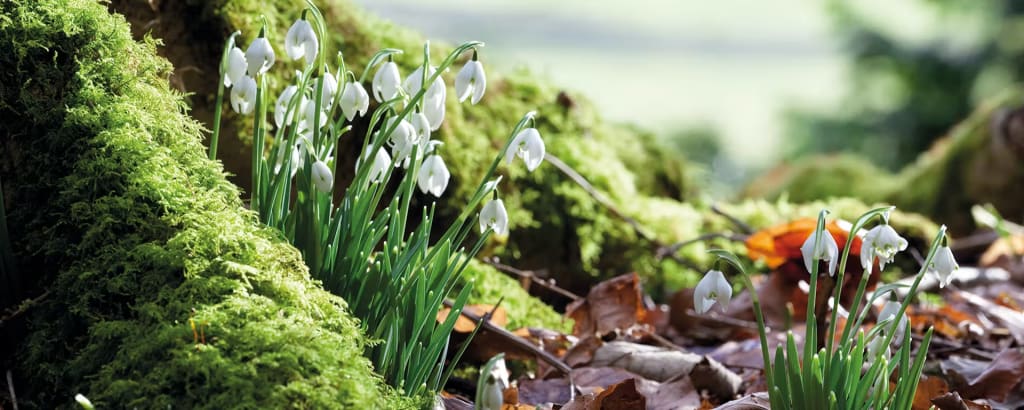
In late winter, snow, sleet, rain, frost, and strong winds are all too prevalent. Take advantage of any dry, sunny days to work in some gardening, but be sure to dress warmly because the temperature might drop below freezing. Winter's hold is easing, which is excellent news. Early flowering bulbs, perennials, and tree and shrub buds are all beginning to emerge, bringing a dash of colour to the otherwise monochromatic picture.
At last! Spring is rapidly approaching.
February at a glance:
* Deadhead winter bedding plants.* Brush off snow from plants.Pruning shrubs developed for their winter stems, such as dogwoods (Cornus), is necessary.
* Inspect tree ties, tightening any that become loosened during windy conditions.
*Summer-blooming deciduous bushes should be pruned.
* Grow begonia tubers indoors.
*Galanthus snowdrops should be purchased and planted "in the green." *Lily bulbs should be planted in the ground or containers.
*Planting shallot bulbs in the ground, *Planting fig (Ficus) trees, and planting Jerusalem artichoke tubers are also recommended.
* Lightly prune heathers that bloom in the summer and the fall.
* Top up beds and borders with mulch
* To stop the spread of fungi, sweep away any fallen leaves and blooms from greenhouse plants.
* Prune back decorative grasses.
* Fork over to rejuvenate soil that has become compacted due to winter rain. *Create a crop rotation strategy
*Horticultural fleece can be used to shield fruit tree early blooms from frost.
*Take action to stop slugs and snails from devouring perennials' new growth.
Plant Snowdrops "In the Green".
Late winter is a good time to buy pot-grown snowdrops (Galanthus), but they may be pricey, especially if you want to make a show.
Buying bare-root plants that are still actively developing or "in the green" is significantly more cost-effective in this situation. Pick a location in dappled shade and add leafmould or garden compost to the soil to boost the soil's ability to retain moisture over the summer. A plant should be positioned in the center of a tiny hole that has been dug with a trowel.
Make sure to backfill with soil, keeping each bulb at the same depth as it was before being raised from the ground.
The soil surface should be level with the point when the green leaves first begin to turn yellow. Rare snowdrops can bring very high prices. Galanthus Plicatus 'Golden Fleece' was the priciest snowdrop in the world in 2015 when a single bulb was purchased on eBay for £1,390 (plus £4 for shipping and handling).
Plant Bergonia Tubers
Larger begonia tubers, measuring 5 cm (2 in) or more in diameter, can be planted in pots made of peat-free, all-purpose potting compost that are 10 to 12 cm (4 in) wide. As tiny pink or white embryonic shoots may be visible, make sure the hollow side is facing up and the curved side is downward. Twist the tuber until the top of the compost is just visible. Some gardeners choose to leave the tubers just protruding from the soil, but doing so will weaken them because they can develop roots all over their surface. To encourage brisk growth, water the pots and set them inside a windowsill propagator. When sprouts start to appear in two to three weeks, pots can be moved to a bright area out of direct sunlight. Try placing them on a window sill that faces east, north, or position them back from a south-facing one. To ensure good growth, water often.
Start out smaller tubers in smaller pots or plant several of them in a seed tray. Make sure to evenly space them apart and keep them from touching to prevent rotting. When the shoots are about 7.5 cm (in) long, lift the tubers out of the seed tray and pot each one separately. From the end of May onward, they can be planted directly into their final containers after they are completely developed.
Mulch you Beds:
Mulching, a strange-sounding term, simply refers to covering the soil with an organic material, such as composted bark, leafmould, well-rotted manure from a farm, or garden compost. Mulch helps plants get nutrients as it rots, locks in moisture, and creates a barrier against weeds in addition to offering a dark backdrop that will properly frame shrubs, perennials, and bulbs. Additionally, the material will shield the roots of delicate plants from the winter's bitter cold and the summer's scorching heat.
Remove weeds from the area before mulching and moisten the soil if necessary. Spread a layer of your preferred material across the entire area at a thickness of 10 cm (4 in), then scrape it into a level surface.
If you're handling composted straw or animal waste, put on gloves.
Don't put mulch against the stems of woody plants or suffocate low-growing plants. It's generally ideal to allow a space around stems so that the mulch does not touch the bark, as this might cause the bark to soften and decay at the base, making plants more susceptible to diseases.
Prune Deciduous Grasses
Plants should be pruned now while they are still largely dormant since deciduous ornamental grasses will soon be churning out plenty of new growth. Secateurs should be used to trim clumps of deciduous grasses like pennisetum, deschampsia, hakonechloa, and related species back to just above ground level while avoiding any new growth. After that, cover plants with 7.5cm (in) of garden compost or something comparable. The management of evergreen grasses shouldn't be so harsh. Put on a pair of gardening gloves, then sift through the clumps with your hands to remove any material that has become stuck there. Snip off any damaged growth as well.
When to Prune Shrubs
The optimal time to prune deciduous shrubs, which flower from midsummer onward, is late winter. These bushes develop blooms on new shoots borne in spring. Pruning these plants shortly after flowering will prevent destroying sleeping buds. Plants that bloom in the spring and early summer frequently blossom on wood produced the previous year. Do not attempt to prune evergreen plants until April or May. This will protect any fragile, sappy growth that has been encouraged by trimming from being harmed by late frosts.
Pruning for Winter Stems
The colourful, bare winter stems of ornamental dogwoods (Cornus), willows (Salix), and thornless brambles (Rubs) are admired. Gardeners used to be instructed to prune these shrubs severely in the early spring, leaving a low, stubby structure, in order to encourage the growth of new stems from the base. Remove only one-third of the elder stems because it is believed that using the entire plant is weakening. However, the plant will be bigger and more impactful while still producing plenty of zingy new shoots.
General rule of shrub pruning
Aim to end up with a shrub that possesses an open, vase-like shape, slenderer at the bottom than at the top.
Start by removing the three Ds: dead, diseased or damaged growth. This will improve the looks of the shrub and will prevent infection spreading to healthy parts of the plant.
Snip off thin wispy shoots, trim back wayward branches and cut out any crossing shoots. Then take out a few of the older stems from the centre to improve air and light flow.
Always prune to an outward-facing bud. Use a 45-degree cut, slanted away from the bud.
Grow Lillies:
Lilies (Lilium) are a hardy tribe that can be grown in beds, borders, and containers. They have flowers that come in a variety of sizes, colors, and shapes, and many of them have strong fragrances. Lilies are simple to care for and will reappear year after year with little effort. Mid- to late spring brings an abundance of young plants in pots, but starting your plants from bulbs will give you a wider selection.
Where to Grow
Lilies do well in the sun or light shade, and they are not picky about the soil as long as it is relatively fertile and well-draining. Shorter varieties can be used to punctuate beds and borders, while taller varieties are ideal for planting at the back of borders or up against walls or fences. Particularly taller forms favor a protected area.
Planting Bulbs in the Ground
Put bulbs in holes that are three times as long as they are, and if your soil is clay, add some horticultural grit to the bottom to improve drainage and keep the bulbs from rotting. Plant bulbs 20cm (8in) apart to give them plenty of room to grow and three to five bulbs per group for the best results.
Growing in Pots
Lilies look especially beautiful in long-Tom terra-cotta pots, which are heavy enough to resist wind blowover and have a tall, narrow shape that emphasizes the form of the flower. To prevent drainage holes from becoming clogged, plug them with pieces of broken pottery. Next, fill them halfway with compost—either John Innes No. 2 or a compost designed specifically for bulb planting.
Before adding compost, arrange three to five bulbs on the surface so they are 10 cm (4 in) below the soil's surface. Ensure a good supply of water
According to the Royal Society for the Prevention of Cruelty to Animals, Cats cannot consume any part of the lily plant, including the leaves and petals.
Pollen may adhere to their coats when they brush past flowers and be ingested while being groomed. Avoid growing any lilies if you are even the slightest bit concerned.
Plant a Fig Tree
Although figs (Ficus), which have their origins in the Middle East, may have an exotic air due to their provenance, it is possible to grow them in colder climates.
There are many varieties that can be sown in the ground right away to produce armfuls of sweet, sticky fruit for many years to come. These varieties are hardy down to -10°C (14 'F).
Due to their remote origins, fig trees require a warm, sunny, and protected location to yield a respectable crop. They can be raised in the open ground or in containers as multistemmed or regular trees.
Another choice is to train young plants against south-facing walls and fences as fans or espaliers.
Many fig trees will happily grow to a height of 6 m (2 ft) or higher if left alone, with a similar spread. Large trees bear the majority of their fruit on branches that are out of reach in addition to obstructing light and taking up space. Larger trees require a lot of moisture and nutrients, so the fruit also tends to be of lower quality.
By limiting the spread of their roots, figs' top growth can be controlled. Building a planting pit—a 60 cm (24 in) square hole with a base of compacted rubble and sides lined with paving slabs—is the traditional method for accomplishing this. Put soil-based potting compost or a combination of regular soil and garden compost in the pit.
Another choice is to plant trees in root control bags, which are 45-litre (10-gallon) fabric containers that can be buried in the ground.
The copper-coated interior of the bags prevents vigorous root tips from growing, which promotes the development of more fibrous side roots.
When do Figs Fruit?
Fig trees can produce three crops a year in warm, remote areas. In cooler climates, pea-sized baby fruit that start to appear in late spring should yield one good crop. These swell throughout the summer and are harvested in August or September. Pick the fruit when it hangs languidly from the branch and gives easily to gentle pressure.
Three Figs to Try:
'Brown Turkey' - ideal in a cool-temperate climate, this popular variety from the 18th century has brown-skinned fruit with red flesh.
'Rouge de Bordeaux' - this old French variety is praised by gourmets for the fine flavour of its small purple fruit with red flesh.
'Panachée' - this 17th-century variety boasts green fruit heavily marked with yellow stripes, which give rise to its common name of tiger fig.
Stop Slugs Eating Hostas;
Slugs and snails, which are drawn to emerging shoots early in the season and enjoy chomping holes in the leaves once they have fully unfolded, make martyrs of hostas. It is best to put control measures in place as soon as shoots poke their heads above ground in late winter and to remain vigilant until summer in order to avoid plants being turned into lace doilies. Slugs can be repelled by surrounding vulnerable plants with organic slug pellets. These pellets not only eliminate pests but also stimulate plant growth by releasing iron and phosphate into the soil. Sadly, no hosta is immune to slug attacks, but some appear to be more hardy. As well as varieties with blue leaves or a heavily corrugated surface, those with thick leaves or those covered in a shiny waxy layer frequently survive unharmed. They include the appropriately named "Invincible," "Daybreak," and "Halcyon."
Remedying Waterlogged Lawns:
Even after spending a week submerged, lawns typically adapt well to wet weather. Wait until the lawn has dried out before aerating with a hollow-tine tool because the weight of surface water is likely to cause compaction. Apply spring lawn fertiliser to replace nutrients that have been lost.
With lawns that have been flooded for more than a week, expect a different result. Water will have displaced the soil's air over this period, and the grass's sickly yellow colour may result from the roots being deprived of oxygen. In this case, remove the deteriorating turf and reseed it or lay new turf from scratch.
About the Creator
Jordan Catto
Late Twenties Lefty Gardener - Writing about the planet, plants and other stuff
Enjoyed the story? Support the Creator.
Subscribe for free to receive all their stories in your feed. You could also pledge your support or give them a one-off tip, letting them know you appreciate their work.






Comments
There are no comments for this story
Be the first to respond and start the conversation.